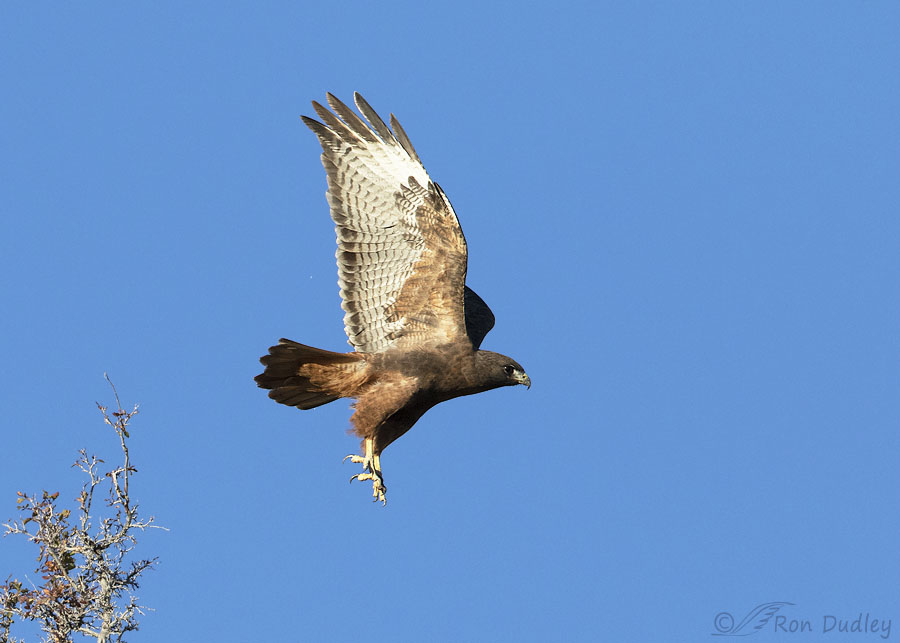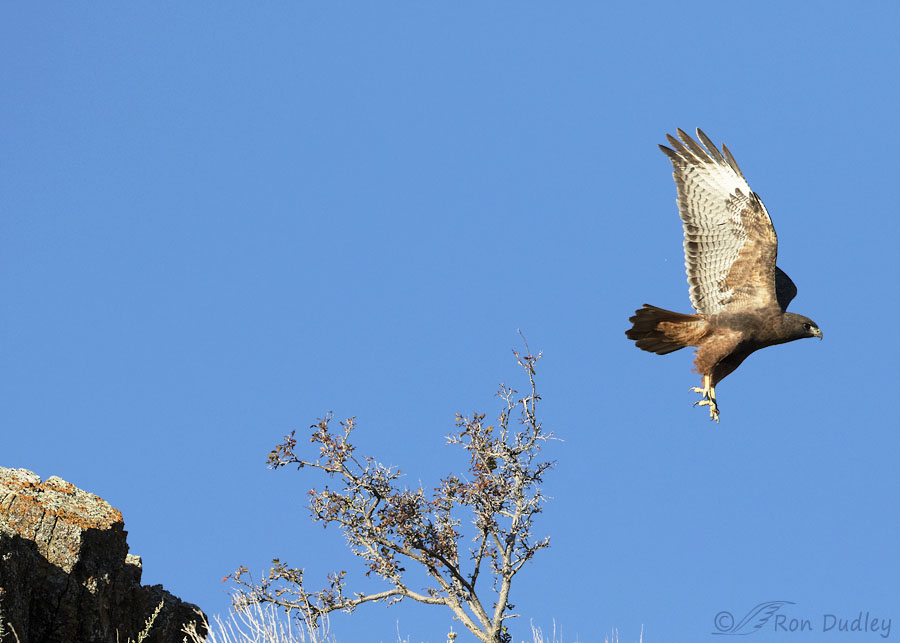And when he took off he was kind enough to demonstrate a flight posture that some folks misinterpret.

1/3200, f/6.3, ISO 640, Canon 7D Mark II, Canon EF 500mm f/4L IS II USM + EF 1.4 III Extender, not baited, set up or called in
Three days ago I relocated the male rufous Red-tailed Hawk and his mate that I’ve been keeping track of and photographing for the last six months or so. I think of both of them as old friends so every time I find them again it’s like a happy reunion, at least for me. For this shot I wasn’t particularly close to him and I wasn’t using my teleconverter so he was pretty small in the uncropped frame.
Before we go any further, how would you interpret this photo? What has just happened?
When I first began photographing raptors I’d have misinterpreted this photo and I suspect there’s a lot of other folks out there who might do the same thing. His feet hanging down, rather than tucked under his tail, strongly suggests that the hawk has taken off recently. That combined with the portion of the bush in the lower left corner of the frame might cause many viewers to assume that the bush is the perch that he took off from.
But that just doesn’t work.
This is a different composition of the same photo. He actually took off from the top of the rock on the far left rather than from the bush.
To the experienced eye, even in the first photo that doesn’t include the rock, it’s pretty obvious that he didn’t take off from right side of the bush. When birds, particularly large heavy raptors, take off they have to push off with their legs and feet so for the first wing flap or two after takeoff their legs and feet are extended mostly backward, not down. At least not straight down like this.
In this photo the hawk is still too close to the right side of the bush for him to have taken off from there and not have his legs still extended backward. This flight posture, with the feet hanging down, only comes later in the takeoff process. Soon after this shot was taken, after he’d gained more flight speed, he tucked his feet and legs under his tail for aerodynamic purposes.
That’s not to say that raptors never have their feet hanging down immediately after takeoff. Takeoffs are dynamic and fluid and depending on the intention of the bird’s launch it’s possible that their feet could be hanging down so soon after takeoff. But in my experience it’s highly unusual.
OK, I’ve beat that drum to death. Apologies to my readers to whom all this is old hat. But I suspect some folks who read this post will learn something.
To some it might only be meaningless minutia but birders and bird photographers tend to be interested in this kind of thing.
Ron



Whatever he’s doing, he sure is looking good while doing it!
Excellent shots Ron, thanks for sharing!
Charlotte Norton
That hawk belongs in the 101st Airborne—he’d make a great paratrooper! OK, he’s not landing but he is a gorgeous guy! I haven’t watched enough take-offs (except from inside a release box after rehab) to really get all their mechanics, so I will definitely pay closer attention to that in the future. Thanks for the lesson, Dr. Dudley! So glad you found this couple again.
Thanks, Chris. I’m always glad to see these two birds. I hope they stick around in the same area for next year’s nesting season.
Excellent observations. Thanks for the lesson. Maybe it’s just me, but they seem scarce here lately.
Lyle, most raptors seem to be unusually scarce in a lot of areas. I just saw a report from HawkWatch International that said this past Golden Eagle nesting season was the “least successful in the last 40 years”.
He is showing off his beautiful pantaloons.
I have obviously learned over the years because I didn’t think take off or landing. And what we could see of that bush looked way too fragile for a take off.
Thanks for another chance to ogle this beauty.
Thank you, EC. Some hawks, Rough-legged Hawks in particular, often prefer to perch on fragile perches like the top of that bush. They’re well known for doing so.
Learning all the time. Which is a most excellent thing. Thank you. Mind you I would expect the branches to be whipped around by take off.
I’ve seen this more frequently in Northern Harriers. As you’re aware they hunt flying near the ground. As they gain a bit of altitude while still searching the ground, I have seen them circling with legs hanging down like this. As you say it’s not a direct result of taking off from a perch.
Yup, harriers do it regularly, Dan. I’ve seen and photographed it very often, including here:
https://www.featheredphotography.com/blog/2015/11/25/northern-harriers-in-flight-where-do-those-long-legs-and-feet-go/
I was going for he’s landing. The next picture was his feet more forward…
Happy you keeping finding them😊
I guess I never considered landing as a possibility, Diana. His wings are held too high for that and he’s not reaching forward with his feet.
I knew the bush wasn’t involved. It looked small and – for a reason I couldn’t articulate – he looked too ‘airborne’ for the bush to have been his perch. But he didn’t look like he was coming in for a landing either. Now I know! I will watch take off sequences more carefully in the future. Thanks, Ron! And what a pretty bird he is.
He’s a looker isn’t he Kathryn.
I thought “landing gear down” but that may be due to once living in a trailer park located just at the end of a runway at Barksdale USAF base. You could hear the THUNK of the wheels going up or down.
“You could hear the THUNK of the wheels going up or down”
Wow, that’s pretty close, Arwen.
Grin, yes, yes it was. Of course, I also had much better hearing back then.
I have seen slow descents from a “cruise,” where the bird’s legs are down, feet half-extended, body facing very slightly downward. That was my interpretation of photo 1. Then I saw the full view and of course realized he’d taken off from the rocks.
Sallie, personally I haven’t seen those descents with the wings held as high as this. I should have mentioned that.
Henry Miller said it best perhaps: “The moment one gives close attention to any thing, even a blade of grass it becomes a mysterious, awesome, indescribably magnificent world in itself.” Keep those small details coming, Ron. We love them. Your audience awaits.
—
Miller was certainly right!
Interesting! I “knew” he wasn’t after something or coming in for a landing but wouldn’t have thought about a take off from a ways back tho bush wouldn’t have made sense! Thx “teach”! 🙂
1st hard freeze this morning – NOT amusing with hauling water – at least it’s pretty much a one shot thing at the moment…….
Thanks, Judy.
My thermometer says 37° right now but my tomatoes and most other things in the garden and yard froze a couple of nights ago.
Beautiful photo Ron. By the way, I learn something almost every time I read your posts! Thanks!
Very good to know. Thank you, Mark.